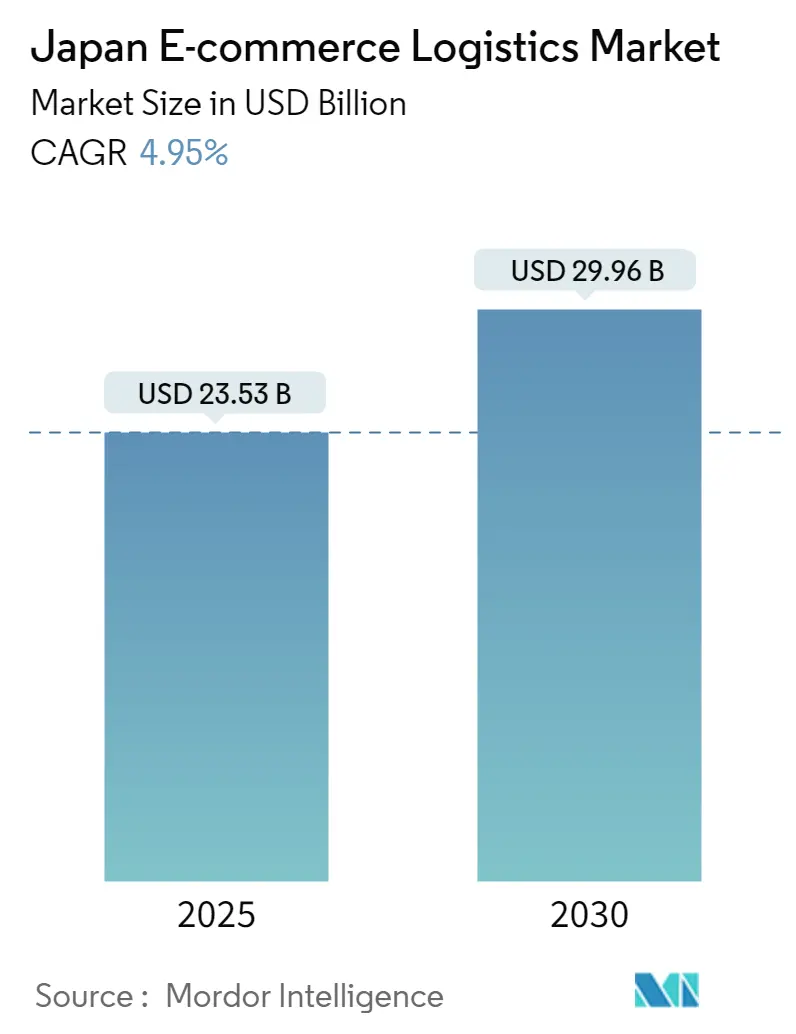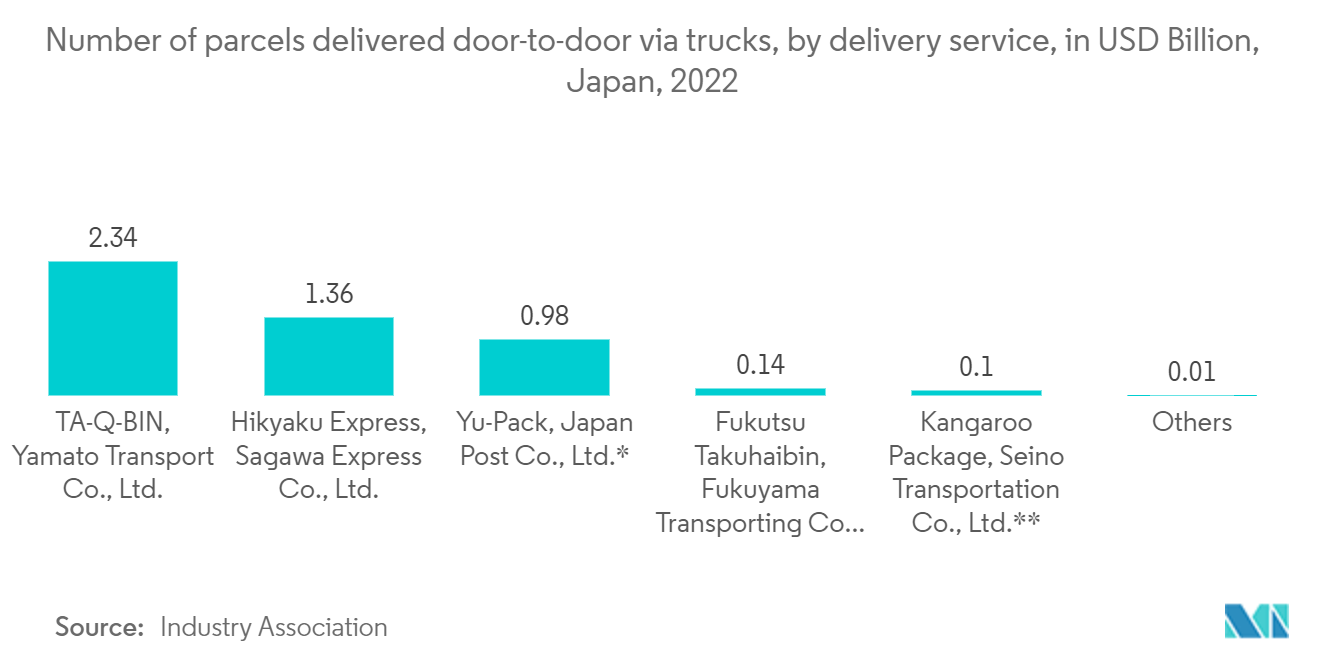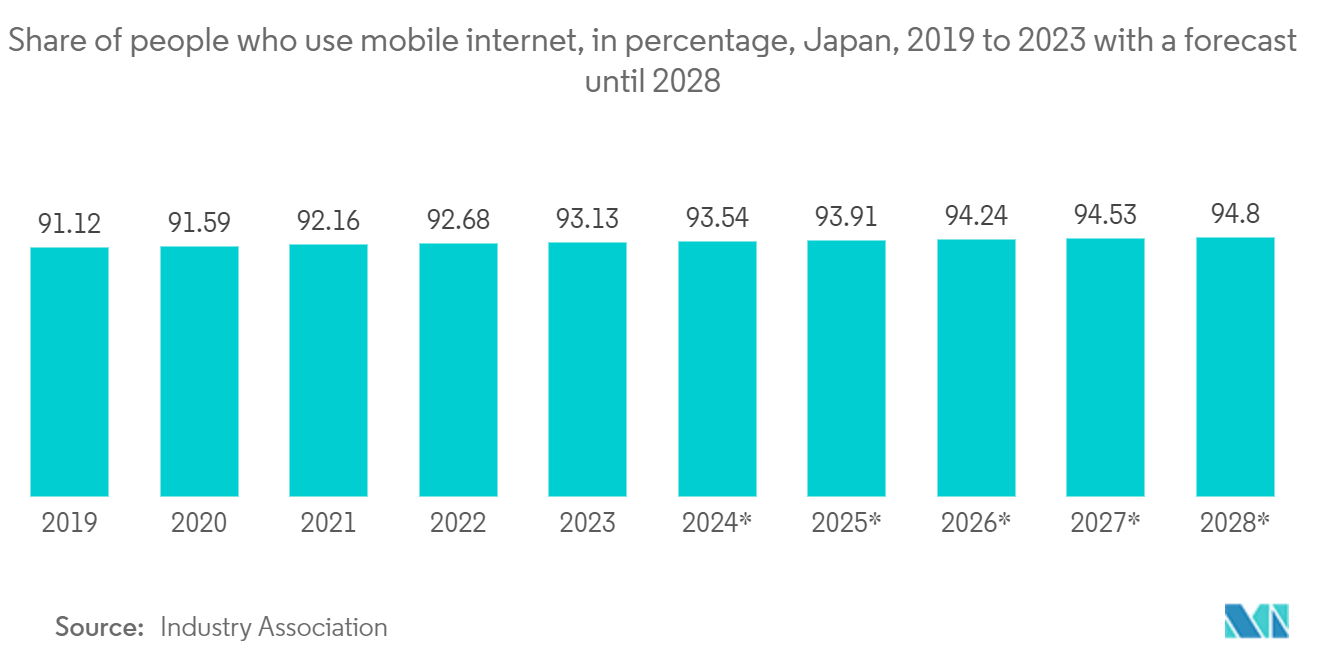Japan E-commerce Logistics Market Size and Share

Japan E-commerce Logistics Market Analysis by Mordor Intelligence
The Japan E-commerce Logistics Market size is estimated at USD 23.53 billion in 2025, and is expected to reach USD 29.96 billion by 2030, at a CAGR of 4.95% during the forecast period (2025-2030).
The e-commerce industry in Japan has witnessed remarkable growth in recent years. With a tech-savvy population and a strong digital infrastructure, Japan has become a major player in the global e-commerce market. Consequently, the demand for efficient and reliable logistics services has also surged.
One of the key factors driving the growth of e-commerce in Japan is the increasing penetration of the Internet and smartphones. Japan’s mobile internet penetration was about 93.8% in 2023 and is expected to reach nearly 95.6% by 2028. Japan’s population is projected to decline from approximately 123.6 m in 2023 to approximately 122.1 m in 2028.
This shift in consumer behavior has created immense opportunities for e-commerce businesses but has also posed challenges for logistics providers.
To meet the demand of the booming e-commerce market, logistics companies in Japan have been investing heavily in technology and infrastructure. They adopt advanced sorting facilities and real-time tracking systems to ensure efficient order processing and delivery.
Sagawa Express, a Japanese logistics and delivery service provider, has partnered with Sumitomo Corporation, a subsidiary of SG Holdings Co. Ltd, and Dexterity Inc., a subsidiary of Dexterity, to power robots powered by Artificial Intelligence (AI) that can load parcel trucks with random boxes. Sagawa Express and Dexterity, one of the world’s leading logistics and delivery services providers, will use Dexterity’s AI to power robots that can load trucks with boxes. Before scaling deployment, the DexR’s dual-arm robot learns from Sagawa Express’s logistics operations, seamlessly integrating into Sagawa’s existing logistics infrastructure.
Last-mile delivery has been a particular focus for logistics providers in Japan. The country's dense urban areas and complex address systems make last-mile delivery challenging. However, companies have been leveraging innovative solutions to overcome these challenges. For instance, they are utilizing crowdsourced delivery networks, partnering with local convenience stores for parcel pick-up, and exploring using drones and autonomous vehicles for delivery in certain areas.
For example, Amazon offers last-mile delivery on a wide range of products in major cities such as Tokyo, Osaka, and Nagoya. The company has invested heavily in logistics infrastructure in Japan, including building new warehouses and delivery centers.
Japan Post offers a same-day delivery service called Yu-Pack Tokkyu. This service is available nationwide and can be used to deliver packages weighing up to 25 kilograms. The growing infrastructure in Japan is making it possible for same-day delivery companies to operate more efficiently and effectively. This is helping to drive the growth of the same-day delivery market in Japan.
Japan E-commerce Logistics Market Trends and Insights
Immense growth projection for transportation segment
In Japan, the transportation segment has seen significant advancements to meet the growing demand of the booming e-commerce market.
Japan's e-commerce transportation segment is dominated by three giant companies that account for more than 90 percent of the domestic parcel delivery market. The biggest one, Yamato Transport, ships more than 1.8 billion parcels annually. A close competitor, Sagawa Express, supplies logistics services to major customers such as Amazon.
One of the key challenges in the transportation segment is the efficient and timely delivery of goods. Logistics companies in a highly populated and geographically diverse country like Japan have had to develop innovative solutions to overcome these challenges. Japan has a population of 122,895,594 as of 2024, according to Worldometer's analysis of the most recent United Nations data.
Japan Post, the country’s third-largest domestic post organization, is likely to follow suit by raising its basic delivery charge and negotiating more competitive rates with key customers. Japan Post has also taken advantage of the domestic shipment management opportunities left by Yamato and Sagawa following the restriction strategy. It has seen tremendous growth in its parcel delivery service, ‘Yupack,’ which was previously available only to enterprise businesses and is now available to private individuals.
However, while the ever-growing demand of nearly 4 billion package deliveries is driving growth in the industry overall, the sheer volume of items that require delivery within Japan is putting pressure on these companies and forcing them all to look for cost savings and process improvements.

High internet and smart phone penetration driving the market
Japan has witnessed remarkable growth in internet and smartphone penetration over the years, making it one of the most connected countries in the world. With its advanced technological infrastructure and tech-savvy population, Japan has embraced the digital revolution with open arms.
Internet penetration in Japan has soared to impressive levels, with a significant portion of the population having access to the internet. As of the latest data, the internet penetration rate in Japan stands at around 93.13%. This means that majority of the Japanese citizens can connect to the internet and enjoy its vast array of services and opportunities.
Japan had 92.9 million active social media users at the beginning of 2023, making up 74.4% of the country's population. At the start of 2023, there were 184.4m cellular mobile connections in the country, making up 149.1% of the population.
One of the driving forces behind Japan's high internet penetration is its robust telecommunications infrastructure. The country boasts a well-developed network of fiber-optic cables, providing high-speed and reliable internet connections to both urban and rural areas. This extensive network ensures that people across the country can access the internet wit ease.
The rise in ecommerce in Japan has led to an increased demand for effcient and reliable logistics services. As more and more people turn to online shopping, the need for seamless delivery and fulfillment becomes crucial. This has paved the way for the evlution of the ecommerce logistics market in Japan.

Competitive Landscape
The e-commerce logistics market in Japan is quite dynamic and competitive, with several key players vying for market share. Some of the major players in the market include Yamato Holdings, Sagawa, Japan Post, Amazon Japan, and Rakuten.
There are also numerous smaller logistics companies and startups that are making their mark in the industry. The competition in the market is intense, with companies constantly innovating and expanding their services to meet the evolving needs of the e-commerce sector.
Amazon.com's cloud computing infrastructure, which is the backbone for AI services, is set to expand significantly in Japan. By 2027, Amazon.com plans to invest USD 2.26 billion in cloud computing facilities in the Tokyo and Osaka metropolitan areas to meet the increasing demand from customers.
Japan E-commerce Logistics Industry Leaders
-
Yamato Holdings
-
Sagawa
-
Japan Post
-
Amazon Japan
-
Rakuten
- *Disclaimer: Major Players sorted in no particular order

Recent Industry Developments
- January 2024: Sagawa Express, Sumitomo Corporation, and Dexterity Inc. Partner to Utilize AI-powered Robots to Load Parcel Trucks in Japan.
- November 2023: Amazon Japan invested more than USD 8 billion in the country in 2023, an increase of 20% from 2022. The company is looking to bolster its logistics and data center infrastructure.
Japan E-commerce Logistics Market Report Scope
The term "e-commerce logistics" refers to the transportation, warehousing, and distribution services the logistics company provides to an online retailer.
The Japanese e-commerce logistics market is segmented by service (transportation, warehousing, and inventory management, and value-added services (labeling, packaging, etc.)), by business (B2B and B2C), by destination (domestic and international/cross-border), and by-product (fashion and apparel, consumer electronics, home appliances, furniture, beauty and personal care products, and other products (toys, food products, etc.)). The report offers market size and forecasts value (USD) for all the above segments.
| Transportation |
| Warehousing and Inventory Management |
| Value-added services (labeling, packaging, etc.) |
| B2B |
| B2C |
| Domestic |
| International/Cross Border |
| Fashion and pparel |
| Consumer electronics |
| Home Appliances |
| Furniture |
| Beauty and Personal care |
| Other products (toys, food products, etc.) |
| By service | Transportation |
| Warehousing and Inventory Management | |
| Value-added services (labeling, packaging, etc.) | |
| By Business | B2B |
| B2C | |
| By Destination | Domestic |
| International/Cross Border | |
| By product | Fashion and pparel |
| Consumer electronics | |
| Home Appliances | |
| Furniture | |
| Beauty and Personal care | |
| Other products (toys, food products, etc.) |
Key Questions Answered in the Report
How big is the Japan E-commerce Logistics Market?
The Japan E-commerce Logistics Market size is expected to reach USD 23.53 billion in 2025 and grow at a CAGR of 4.95% to reach USD 29.96 billion by 2030.
What is the current Japan E-commerce Logistics Market size?
In 2025, the Japan E-commerce Logistics Market size is expected to reach USD 23.53 billion.
Who are the key players in Japan E-commerce Logistics Market?
Yamato Holdings, Sagawa, Japan Post, Amazon Japan and Rakuten are the major companies operating in the Japan E-commerce Logistics Market.
What years does this Japan E-commerce Logistics Market cover, and what was the market size in 2024?
In 2024, the Japan E-commerce Logistics Market size was estimated at USD 22.37 billion. The report covers the Japan E-commerce Logistics Market historical market size for years: 2020, 2021, 2022, 2023 and 2024. The report also forecasts the Japan E-commerce Logistics Market size for years: 2025, 2026, 2027, 2028, 2029 and 2030.
Page last updated on:
Japan E-commerce Logistics Market Report
Statistics for the 2025 Japan E-commerce Logistics market share, size and revenue growth rate, created by Mordor Intelligence™ Industry Reports. Japan E-commerce Logistics analysis includes a market forecast outlook for 2025 to 2030 and historical overview. Get a sample of this industry analysis as a free report PDF download.



